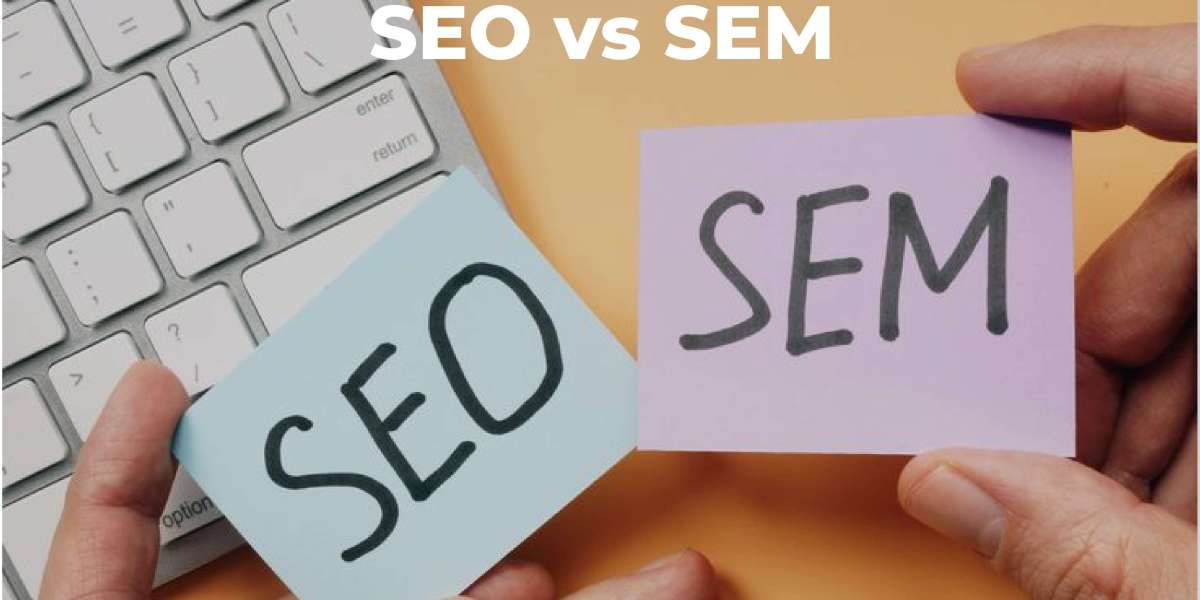In the world of digital marketing, two key tactics stand out: Search Engine Optimization (SEO) and Search Engine Marketing. While they both attempt to improve a website's visibility and attract traffic from search engines, they work differently and serve different functions. In this blog post, we'll look at the complexities of SEO vs SEM, their distinctions, and how they might work together to reach larger marketing objectives.
What is SEO?
SEO is the practice of optimizing a website so that it ranks higher in organic (unpaid) search results. The purpose of SEO is to improve a website's exposure for relevant search queries, resulting in increased organic traffic.
Key components of SEO include:
On-page SEO entails tailoring website content, meta tags, headers, and URLs to match specified keywords.
Off-page SEO is the process of acquiring high-quality backlinks from respected websites in order to increase domain authority and trustworthiness.
Technical optimization entails improving website performance, mobile friendliness, and user experience to match search engine requirements.
What is SEM?
SEM, on the other hand, refers to paid advertising methods that improve a website's exposure in search engine results pages (SERPs). Unlike SEO, which focuses on organic traffic, SEM uses paid placements to provide targeted visitors to a website. The main component of SEM is:
Pay-Per-Click (PPC) ads: Bidding on keywords and displaying adverts prominently in search engine results. Advertisers pay a charge each time a user clicks on their ad.
SEO vs SEM: Choosing the Right Strategy
The decision between SEO and SEM is determined by a number of factors.
1. Budget: SEO is typically more cost-effective in the long run but requires ongoing investment in content creation, optimization, and link building. SEM, on the other hand, involves immediate costs for clicks and impressions but offers more control over spending.
2. Timeline: If you need immediate results and are willing to invest in paid advertising, SEM may be the preferred option. However, if you're looking for sustainable, long-term growth, SEO is the way to go, albeit with a longer timeline for results.
3. Marketing Objectives: Consider your specific marketing goals when choosing between SEO and SEM. If brand awareness, lead generation, or immediate sales are your priorities, SEM may be the best choice. If you aim to build organic visibility, authority, and trust over time, prioritize SEO efforts.
Key Differences Between SEO vs SEM
Cost: SEO is often a long-term investment that takes time and work to see returns. While the direct expenditures are small, the resources required for content production, optimization, and link building can mount up. SEM, on the other hand, incurs immediate fees for each click on an ad, making it a more predictable but potentially costly technique.
Visibility: SEO aims to improve organic search ranks and maintain exposure over time. In contrast, SEM delivers immediate awareness through paid spots but fades after the advertising budget is depleted.
Traffic Quality: Organic traffic obtained by SEO is generally of higher quality because it indicates people' real interest in the material or products offered. While SEM traffic is targeted, some people may click on ads out of curiosity or impulse, resulting in varied levels of engagement and conversion rates.
Control and Flexibility: SEM provides more control and flexibility in ad targeting, budget allocation, and campaign optimization. Advertisers may optimize performance by adjusting bids, ad wording, and targeting factors in real time. While SEO is effective, it is dependent on algorithm upgrades and external factors over which we have no direct influence.
Complementary Roles of SEO and SEM
While SEO vs SEM have distinct approaches, they can work synergistically to enhance a website's overall visibility and performance:
Maximizing Visibility: By combining SEO vs SEM, firms may capture a larger part of search engine real estate, appearing in both organic and paid listings for specific keywords.
Data Insights: SEM campaigns provide useful information on keyword performance, user behavior, and conversion metrics that may be used to improve SEO efforts. SEM insights can help with content improvement, keyword targeting, and user experience enhancements.
Brand Exposure: SEM can help to increase brand exposure and visibility, especially for new websites or specialist businesses where organic rankings may be difficult to acquire at first.
Seasonal or Time-Sensitive Promotions: SEM is ideal for promoting limited-time deals, seasonal specials, and time-sensitive promotions that require quick visibility and traffic.
Conclusion
To summarize, SEO and SEM are two critical pillars of digital marketing, each with unique capabilities and purposes. While SEO emphasizes long-term organic development and visibility, SEM provides instant results through paid advertising. Businesses may design comprehensive plans to maximize their online presence, attract quality traffic, and achieve their marketing objectives by recognizing the differences between SEO and SEM and exploiting their complementary roles.By understanding the differences and benefits of SEO vs SEM, businesses can make informed decisions and find the right balance between the two strategies to achieve their marketing objectives.








